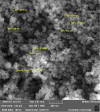Evaluating the therapeutic effect of different forms of silymarin on liver status and expression of some genes involved in fat metabolism, antioxidants and anti-inflammatory in older laying hens
- PMID: 39324876
- PMCID: PMC11426161
- DOI: 10.1002/vms3.70025
Evaluating the therapeutic effect of different forms of silymarin on liver status and expression of some genes involved in fat metabolism, antioxidants and anti-inflammatory in older laying hens
Abstract
Background: Silymarin, the predominant compound of milk thistle, is an extract took out from milk thistle (Silybum marianum) seeds, containing a mixture of flavonolignans with strong antioxidant capability.
Methods: The experiment was conducted using 70 Lohmann LSL-Lite hens at 80 weeks of age with 7 treatments each with 10 replicates. Treatments included: (1) control diet without silymarin, (2) daily intake of 100 mg silymarin powder/kg body weight (BW) (PSM100), (3) daily intake of 200 mg silymarin powder/kg BW (PSM200), (4) daily intake of 100 mg nano-silymarin/kg BW (NSM100), (5) daily intake of 200 mg nano-silymarin/kg BW (NSM200), (6) daily intake of 100 mg lecithinized silymarin/kg BW (LSM100) and (7) daily intake of 200 mg lecithinized silymarin/kg BW (LSM200). The birds were housed individually, and diets were fed for 12 weeks.
Results: Scanning electron microscopy showed that NSM was produced with the average particle size of 20.30 nm. Silymarin treatment improved serum antioxidant enzyme activity. All groups receiving silymarin showed a decrease in liver malondialdehyde content, expression of fatty acid synthase, tumour necrosis factor alpha, interleukin 6 (IL-6) genes in the liver, and hepatic steatosis than the control, except those fed the PSM100 diet. There were decreases in liver dry matter and fat contents, non-alcoholic fatty liver disease and hepatocyte ballooning, and an increase in glutathione peroxidase gene expression and a decrease in iNOS gene expression in birds fed the NSM100, NSM200, LSM100 and LSM200 diets compared to the control group. Moreover, all groups receiving silymarin showed a significant decrease in liver weight compare to the control group.
Conclusions: Overall, the effects of silymarin when converted to NSM or LSM and offered at the level of 200 mg/kg BW were more pronounced on the hepatic variables and may be useful in the prevention of the liver disease in older laying hens.
Keywords: hepatic steatosis; laying hens; lecithin; nano‐silymarin.
© 2024 The Author(s). Veterinary Medicine and Science published by John Wiley & Sons Ltd.
Conflict of interest statement
The authors declare no conflicts of interest.
Figures


Similar articles
-
Guanidinoacetic acid in laying hen diets with varying dietary energy: Productivity, antioxidant status, yolk fatty acid profile, hepatic lipid metabolism, and gut health.Poult Sci. 2025 Jul;104(7):105159. doi: 10.1016/j.psj.2025.105159. Epub 2025 Apr 13. Poult Sci. 2025. PMID: 40267570 Free PMC article.
-
Effects of dietary supplementation with bile acids on growth performance, antioxidant capacity, lipid metabolism, and cecal microbiota of Danzhou chickens.Poult Sci. 2025 Aug;104(8):105276. doi: 10.1016/j.psj.2025.105276. Epub 2025 May 7. Poult Sci. 2025. PMID: 40373624 Free PMC article.
-
Synergistic effects of copper and bile acids on cholesterol reduction in eggs of laying hens.Poult Sci. 2025 Jul;104(7):105202. doi: 10.1016/j.psj.2025.105202. Epub 2025 Apr 22. Poult Sci. 2025. PMID: 40286571
-
An updated systematic review of the pharmacology of silymarin.Forsch Komplementmed. 2007 Apr;14(2):70-80. doi: 10.1159/000100581. Epub 2007 Apr 23. Forsch Komplementmed. 2007. PMID: 17464157
-
Lipid profiles and production performance responses of laying hens to dietary Moringa oleifera leaf meal: systematic review and meta-analysis.Trop Anim Health Prod. 2023 Jul 27;55(4):277. doi: 10.1007/s11250-023-03693-2. Trop Anim Health Prod. 2023. PMID: 37500961
References
-
- Akit, H. , Sazili, A. Q. , Ismail, N. A. , Atan, N. A. , & Loh, T. C. (2016). Effect of dietary soy lecithin on laying performance, egg quality and meat texture of aged layer hen. Pertanika Journal of Tropical Agricultural Science, 39, 365–372.
MeSH terms
Substances
LinkOut - more resources
Full Text Sources
Medical

